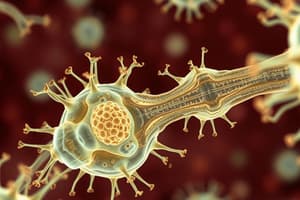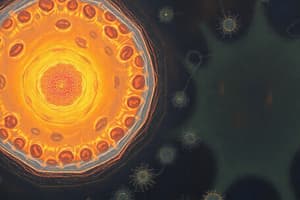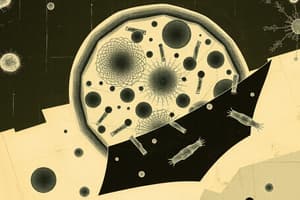Podcast
Questions and Answers
Which of the following characteristics is NOT associated with prokaryotic cells?
Which of the following characteristics is NOT associated with prokaryotic cells?
- Lack of membrane-bound organelles
- Cell wall for support and protection
- Presence of a nucleoid region
- Presence of a nucleus (correct)
Which of the following best describes the function of the Golgi apparatus?
Which of the following best describes the function of the Golgi apparatus?
- Synthesizing proteins
- Processing and packaging proteins (correct)
- Breaking down cellular waste
- Generating ATP through cellular respiration
Which component of the cell membrane is primarily responsible for creating a barrier to the movement of hydrophilic molecules?
Which component of the cell membrane is primarily responsible for creating a barrier to the movement of hydrophilic molecules?
- Membrane proteins
- Cholesterol molecules
- Hydrophilic heads of phospholipids
- Hydrophobic tails of phospholipids (correct)
What is the primary function of mitochondria in eukaryotic cells?
What is the primary function of mitochondria in eukaryotic cells?
During which phase of mitosis do sister chromatids separate and move to opposite poles of the cell?
During which phase of mitosis do sister chromatids separate and move to opposite poles of the cell?
Which type of cell junction is responsible for forming a tight seal between cells, preventing the leakage of fluids across a cell layer?
Which type of cell junction is responsible for forming a tight seal between cells, preventing the leakage of fluids across a cell layer?
What is the role of lysosomes in the cell?
What is the role of lysosomes in the cell?
In protein synthesis, what is the function of transfer RNA (tRNA)?
In protein synthesis, what is the function of transfer RNA (tRNA)?
During DNA replication, which enzyme is responsible for catalyzing the synthesis of a new DNA strand?
During DNA replication, which enzyme is responsible for catalyzing the synthesis of a new DNA strand?
What is the significance of crossing over during meiosis?
What is the significance of crossing over during meiosis?
Flashcards
Cell biology
Cell biology
Study of cells, including their structure, function, and behavior.
Plasma membrane
Plasma membrane
Encloses the cell, separating its interior from the external environment.
Prokaryotic Cells
Prokaryotic Cells
Cells lacking a nucleus and other membrane-bound organelles (e.g., bacteria).
Eukaryotic Cells
Eukaryotic Cells
Signup and view all the flashcards
Cell Membrane
Cell Membrane
Signup and view all the flashcards
Nucleus
Nucleus
Signup and view all the flashcards
Endoplasmic Reticulum (ER)
Endoplasmic Reticulum (ER)
Signup and view all the flashcards
Golgi Apparatus
Golgi Apparatus
Signup and view all the flashcards
Lysosomes
Lysosomes
Signup and view all the flashcards
Mitochondria
Mitochondria
Signup and view all the flashcards
Study Notes
- Cell biology studies cells' structure, function, and behavior.
- Cell biology explores cell physiology, metabolism, signaling, life cycle, chemical composition, and interactions with the environment.
- Cell biology research is performed on both prokaryotic and eukaryotic cells.
- Understanding cell biology is crucial for understanding tissues, organs, and entire organisms.
Cell Structure
- Cells are generally microscopic, ranging from 1 micrometer to millimeters in size.
- Viruses, ranging from 20-300 nanometers, are smaller than cells.
- All cells are enclosed by a plasma membrane, a lipid bilayer with embedded proteins.
- The plasma membrane separates the cell's interior from the external environment.
Prokaryotic Cells
- Prokaryotes include bacteria and archaea.
- Prokaryotes lack a nucleus and other membrane-bound organelles.
- Their DNA is located in the cytoplasm in a region called the nucleoid.
- Prokaryotic cells are typically smaller and simpler than eukaryotic cells.
- Prokaryotes possess a cell wall for support and protection.
- Ribosomes are present as small particles involved in protein synthesis in prokaryotes.
- Some prokaryotes have flagella for movement.
Eukaryotic Cells
- Eukaryotes include protists, fungi, plants, and animals.
- Eukaryotic cells feature a nucleus and other membrane-bound organelles.
- The nucleus in eukaryotes contains DNA, organized into chromosomes.
- Organelles like mitochondria, endoplasmic reticulum, Golgi apparatus, and lysosomes perform specific functions inside eukaryotic cells.
- Eukaryotic cells are generally larger and more complex than prokaryotic cells.
- Plant cells have chloroplasts for photosynthesis and a cellulose cell wall.
- Animal cells lack chloroplasts and cell walls.
Cell Membrane
- The cell membrane is a selective barrier regulating the passage of substances.
- The cell membrane is composed of a phospholipid bilayer, with hydrophilic heads facing outward and hydrophobic tails facing inward.
- Membrane proteins perform functions including transport, signaling, and cell adhesion.
- The fluid mosaic model describes the cell membrane's dynamic nature, allowing lipids and proteins to move laterally within the bilayer.
Nucleus
- The nucleus is the control center of the cell, containing DNA.
- The nucleus is surrounded by a double membrane, the nuclear envelope, with nuclear pores that regulate molecule movement between the nucleus and cytoplasm.
- Within the nucleus, DNA is organized into chromosomes that are composed of chromatin (DNA and proteins).
- The nucleolus, within the nucleus, synthesizes ribosomes.
Cytoplasm
- The cytoplasm is the gel-like substance within the cell, excluding the nucleus.
- The cytoplasm contains organelles and the cytoskeleton, which provides structural support and facilitates cell movement.
- Glycolysis and protein synthesis occur in the cytoplasm.
Endoplasmic Reticulum (ER)
- The endoplasmic reticulum is a network of interconnected membranes in the cytoplasm.
- Rough ER is studded with ribosomes, involved in protein synthesis and modification.
- Smooth ER lacks ribosomes and is involved in lipid synthesis, detoxification, and calcium storage.
Golgi Apparatus
- The Golgi apparatus is a series of flattened membrane-bound sacs called cisternae
- The Golgi apparatus processes and packages proteins and lipids synthesized in the ER.
- Proteins are modified, sorted, and packaged into vesicles for transport by the Golgi apparatus.
Lysosomes
- Lysosomes are membrane-bound organelles filled with enzymes.
- Lysosomes break down cellular waste, debris, and ingested materials.
- Lysosomes play a role in autophagy and apoptosis.
Mitochondria
- Mitochondria generate ATP through cellular respiration, acting as the cell's powerhouses.
- Mitochondria feature a double membrane structure, with an inner membrane folded into cristae.
- Mitochondria contain their own DNA and ribosomes, and are thought to have originated from endosymbiotic bacteria.
Chloroplasts
- Chloroplasts are found in plant cells and algae, as the site of photosynthesis.
- Chloroplasts contain chlorophyll, a pigment that captures light energy.
- Chloroplasts feature a double membrane structure and contain thylakoids called grana.
- Like mitochondria, chloroplasts have their own DNA and ribosomes.
Cytoskeleton
- The cytoskeleton is a network of protein fibers, providing structural support, facilitating cell movement, and materials transport.
- There are three main types of cytoskeletal fibers.
- Microfilaments (actin filaments) are involved in cell shape, movement, and muscle contraction.
- Intermediate filaments provide structural support and stability.
- Microtubules are involved in cell division, intracellular transport, and the formation of cilia and flagella.
Cell Junctions
- Cell junctions are structures that connect cells to each other and to the extracellular matrix.
- Tight junctions form a tight seal between cells, preventing fluid leakage across the cell layer.
- Adherens junctions and desmosomes provide strong adhesion between cells.
- Gap junctions allow direct communication between cells through the passage of ions and small molecules.
Cell Communication
- Cells communicate with each other through chemical signals.
- Signaling molecules are secreted by cells, traveling through the bloodstream to reach target cells.
- Receptors on the cell surface or inside the cell bind to signaling molecules and initiate a response.
- Signal transduction pathways amplify and relay signals, altering gene expression or cellular activity.
Cell Cycle
- The cell cycle is the series of events from one cell division to the next.
- It consists of two main phases: interphase and mitosis.
- Interphase involves cell growth and DNA replication, divided into G1, S, and G2 phases.
- Mitosis is the process of nuclear division, followed by cytokinesis.
Mitosis
- Mitosis produces two identical daughter cells.
- Mitosis consists of prophase, metaphase, anaphase, and telophase.
- During prophase, chromosomes condense, the nuclear envelope breaks down, and mitotic spindle forms.
- During metaphase, chromosomes align at the metaphase plate.
- During anaphase, sister chromatids separate and move to opposite poles of the cell.
- During telophase, chromosomes decondense, the nuclear envelope reforms, and cytokinesis begins.
Meiosis
- Meiosis produces four haploid gametes (sex cells) from a single diploid cell.
- Meiosis includes meiosis I and meiosis II.
- Meiosis I separates homologous chromosomes, and meiosis II separates sister chromatids.
- Crossing over occurs during prophase I, resulting in genetic recombination.
Apoptosis
- Apoptosis is programmed cell death, eliminating damaged or unwanted cells.
- Apoptosis is crucial in development, tissue homeostasis, and immune function.
- Apoptosis is characterized by cell shrinkage, DNA fragmentation, and the formation of apoptotic bodies.
- Apoptotic bodies are engulfed by phagocytes, preventing inflammation.
Cell Metabolism
- Cell metabolism includes all the chemical reactions that occur within a cell.
- Cell metabolism includes catabolism and anabolism.
- Enzymes catalyze metabolic reactions.
- ATP is the main energy currency of the cell.
Cellular Respiration
- Cellular respiration generates ATP from glucose and other organic molecules.
- Cellular respiration includes glycolysis, the citric acid cycle (Krebs cycle), and oxidative phosphorylation.
- Glycolysis occurs in the cytoplasm, breaking down glucose into pyruvate.
- The citric acid cycle occurs in the mitochondrial matrix, oxidizing pyruvate to carbon dioxide.
- Oxidative phosphorylation occurs in the inner mitochondrial membrane, producing ATP through the electron transport chain and chemiosmosis.
Photosynthesis
- Photosynthesis converts light energy into chemical energy in the form of glucose.
- Photosynthesis includes the light-dependent reactions and the Calvin cycle.
- The light-dependent reactions occur in the thylakoid membranes, converting light energy into ATP and NADPH.
- The Calvin cycle occurs in the stroma and uses ATP and NADPH to fix carbon dioxide and produce glucose.
Protein Synthesis
- Protein synthesis produces proteins from amino acids, instructed by DNA.
- Protein synthesis includes transcription and translation.
- Transcription synthesizes mRNA from a DNA template in the nucleus, using RNA polymerase.
- Translation uses mRNA to assemble a protein from amino acids in the cytoplasm, using ribosomes.
- tRNA molecules carry amino acids to the ribosome.
DNA Replication
- DNA replication copies DNA before cell division.
- DNA replication is semiconservative, with each new DNA molecule consisting of one original strand and one newly synthesized strand.
- DNA polymerase catalyzes DNA synthesis.
- DNA replication begins at origins of replication and proceeds bidirectionally.
Cell Differentiation
- Cell differentiation is the process by which cells become specialized in structure and function.
- During development, cells receive signals that activate or repress specific genes, leading to different cell types.
- Stem cells are undifferentiated cells with the potential to differentiate into various cell types.
Studying That Suits You
Use AI to generate personalized quizzes and flashcards to suit your learning preferences.
Description
Explore cell biology focusing on structure and prokaryotic organisms. Learn about cell size, plasma membranes, and the key characteristics of prokaryotic cells, including their lack of a nucleus and the presence of a nucleoid region. Understand the basics of cell biology.




